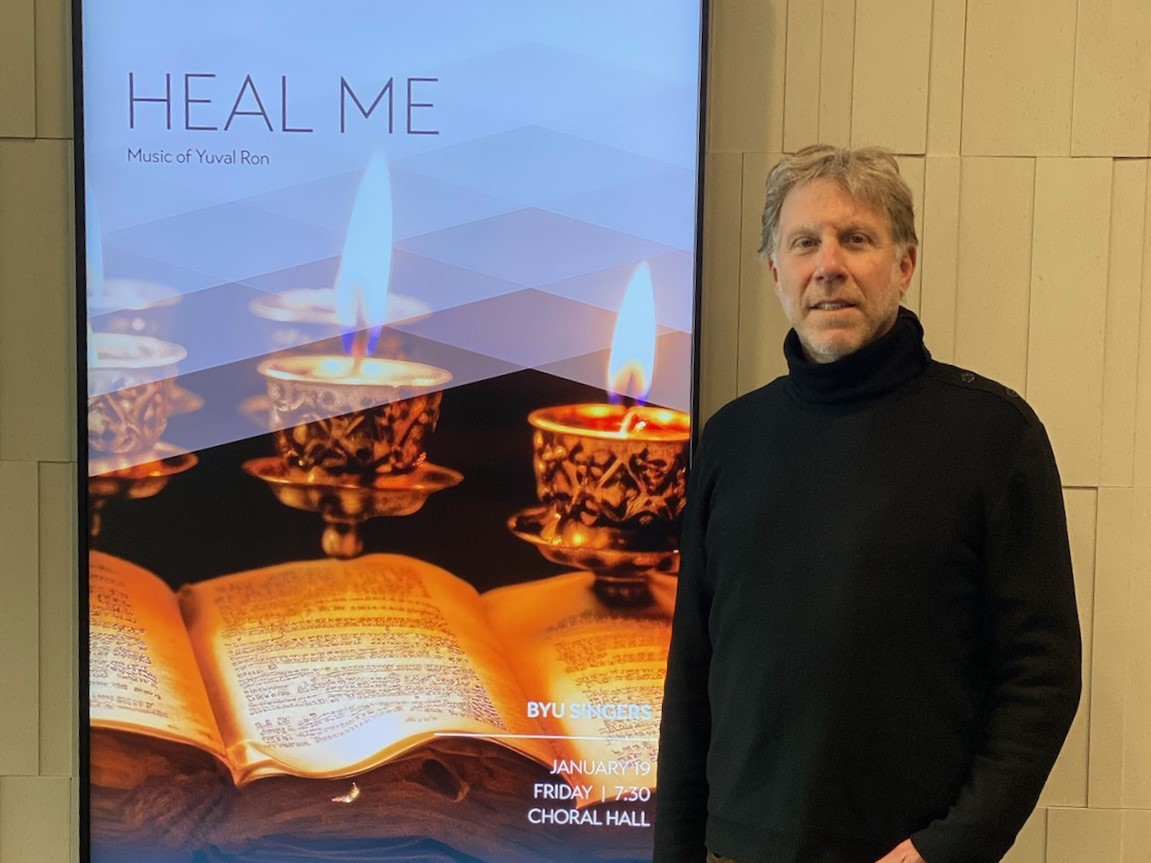
Award-winning Israeli composer Yuval Ron’s new work premiered live at BYU on Friday, Jan. 19, sung by BYU Singers.
Ron is a music therapy composer and his new choral composition, “Heal Me,” is the first a cappella song cycle tuned at 40 hertz (cycles per second). According to Richard Gold, executive producer and president of Metta Mindfulness Music, the tone of 40 hertz can improve brain function and aid in healing cognitive illnesses such as schizophrenia and depression.
Because of his interest in meditation and recent neuroscience, Gold said he introduced the idea of composing music at the tone of 40 hertz to Ron.
“What initiated the discussion was my interest in meditation and the emerging neuroscience around the brain and meditation,” Gold said. “I asked if there was a way to bring a higher level of musicality to the music that’s being used to facilitate meditation.”
Most 40 hertz sound therapy used in past research has only used raw sounds instead of music, Gold said.
The 40 hertz frequency has been found to improve sleep, regulate mood and alleviate symptoms of schizophrenia, epilepsy, Alzheimer’s and other neurological disorders, Gold said. It can also help with memory and recall, and listening to 40 hertz sounds or music before studying can be beneficial to one’s study session.
“It cleans and clears the neural pathways of the brain,” Gold said regarding the 40 hertz frequency. Gold added that he hopes if the brain is brought up to a more dynamic potential via the 40 hertz frequency, then symptoms of cognitive illnesses, such as epilepsy and other illnesses that lessen brain function, can diminish.
This research on 40 hertz sound therapy comes from the Massachusetts Institute of Technology.
Based on early research found at Harvard which revealed that meditating for about 40 minutes a day leads to measurable changes in brain structure and neuron communications in the brain, Gold recommended listening to 40 hertz music for 40 days, 40 minutes each day.
40 hertz is tuned about a quarter tone lower than E1 on the keyboard, Ron said. The typical tuning of a note is at A4=440 hertz, while this choral piece was tuned at A4=427.15.
When composing “Heal Me,” Ron said he also considered the words sung on top of the 40 hertz tuning.
“I didn’t want the singers just to sing ‘oohs’ and ‘aahs,’” Ron said. “I was looking for inspiring texts that are moving and meaningful. I heard some people in Jewish communities that chanted of Moses, Moses praying to God asking for Miriam, his sister, to be healed, (with) ‘El na refa na, El na refa na.’” Ron used this text for the first movement in the song cycle.
Ron also expressed the importance of using the original language of Hebrew in the composition because it has the original sounds and healing power through the music in the language.
The second movement of the song cycle is based on Jeremiah asking God to heal him, while the third movement is based on the Psalm of King David asking God to heal him.
“There’s a whole tradition of chanting Psalms in Judeo-Christian traditions when times are difficult,” Ron said.
Ron explained it was custom to stand by the bed of someone who is dying and chant Psalms.
“There have been many times where the person who is on their deathbed actually recovered, and so people start believing in this tradition that the Psalms have the power to have miraculous healing,” Ron said.
Upon learning about BYU Singers, Ron listened to their past recordings as he considered who would sing his choral composition. He said he was impressed with the quality, devotion, feeling and professional sound of the choir.
After Ron presented the choral piece to BYU professor and conductor of the BYU Singers, Andrew Crane, Ron said Crane suggested hosting a public performance of the song cycle in addition to the professional recording.
Julie Burgess from Provo found the concept of this concert intriguing.
“I graduated from BYU in music and I’m also a composer,” Burgess said. “My husband’s a therapist and so it was kind of a meeting of our worlds, so we wanted to kind of just see what it was all about.”
The BYU Singers recorded this song cycle in a professional studio setting on Jan. 18 and Jan. 19, before performing the piece for a live audience in the Music Building’s Choral Hall. Ron and Gold said they anticipate the recording to be available in a few months.
When the official studio recording is available, those interested in listening can find it at mettamindfulnessmusic.com.




